Many people are surprised to learn that chickens don’t (and shouldn’t) sleep in nests. Rather, chickens sleep on roosts. If we humans tried to sleep while balancing on a bar, we’d fall off, but birds curl their feet around the roost, and lock their flexor tendons, so that even when thoroughly relaxed, they stay put. (Think about it. This is why you don’t see birds falling out of trees when they take naps!) I take chicken anatomy into account when building roosts for my coops. I like round bars – it’s easier for the hens to stay latched on. Some people advocate for flat roosts, thinking that the hens can better cover their cold toes with their feathers. My hens hunker down just fine on round roosts, and they haven’t had frozen toes yet.
You might think, but wouldn’t they be cozier in nests? The answer is no. Chickens produce manure all day and all night. They poop. A lot. If they sleep in the nesting boxes, then they’re sitting on a pile of damp manure. Eggs laid in those nesting boxes will be filthy. When chickens sleep on a roost, their manure drops down into the bedding and the hens don’t breathe in moisture and ammonia fumes all night. This is why roosts should be up high and why coops built like dog houses are a bad idea. If your chickens are roosting only a few inches off of the floor of the coop, then they’ll be prone to respiratory ailments all year round, and frostbite in the winter.
Despite the benefits of roosting, some chickens might decide to sleep in the nesting boxes. An ill chicken may take to a nesting box. Sometimes a hen that is molting will stay in a box because she is feeling (literally) prickly, and her pecking order has been shaken up because of her exposed skin; the box will feel like a safe place to her. Broody hens will also sleep in nesting boxes. You can take a hen from a nesting box and put her on the roost at dusk, and often (but not always) she’ll stay put. Young birds need to learn to roost. I’ve written about that here and here.
The dowels should be about 1 1/2 inches in diameter. Plan on at least six inches of roost per bird. In the winter they’ll huddle up for warmth, in the summer they won’t crowd so tightly together. Hens are fussy about who they sleep next to, so plenty of space will prevent squabbles.
Note that this roost is attached to the wall with hinges. I can lift it up to clean underneath it. Also note that it leans against the wall at a slant. That way the hens on the lower rungs don’t get pooped on by the girls above. I like tiered roosts because the old hens use the steps to make their way to the top, and to get down again in the morning.
Roosts are also used during the daytime. Betsy, who is a very, very old hen, rests indoors while the others are out and about. It’s a peaceful place for her.
I provide plenty of outside roosts, too. It’s a way to create more usable space in a small pen. Roosts are especially welcome when it’s muddy and snowy as the hens appreciate perches that are high and dry. Branches make for attractive and interesting roosts.
Roosts also enrich the environment. I keep stumps in the run, and move them about every week or so. The hens seem to like the change of scenery.
Veronica likes the top of the ladder.
Phoebe also makes use of the roost. The inside corner protects her from bothersome chicken feet, but still allows her to be right in the middle of the action.
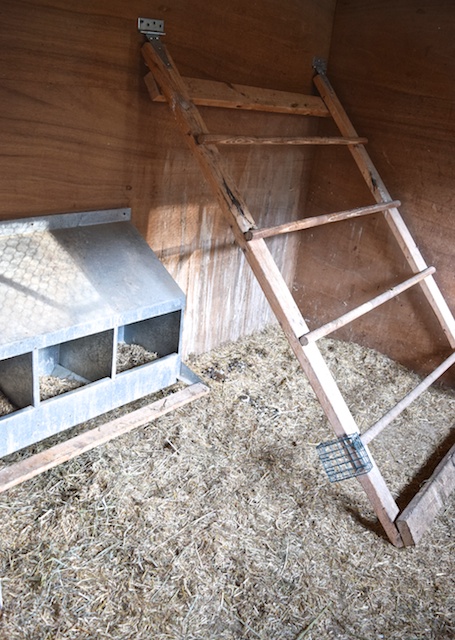
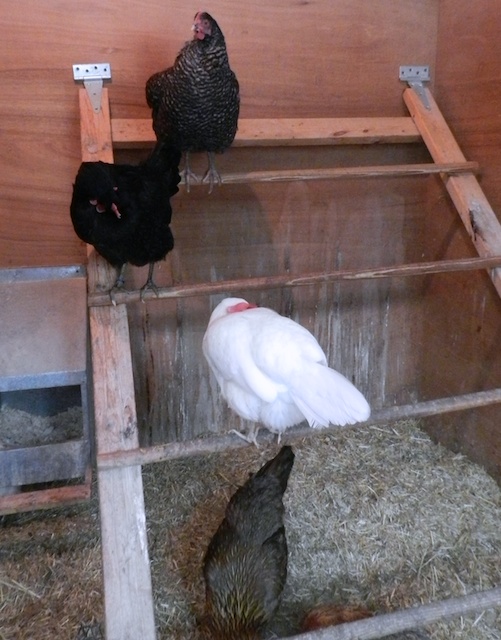
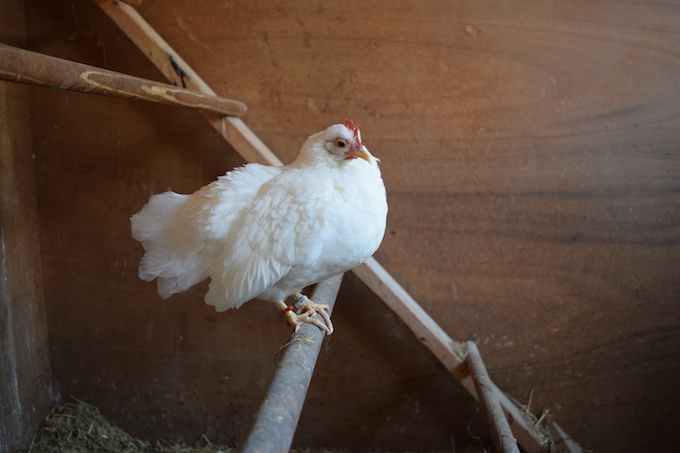

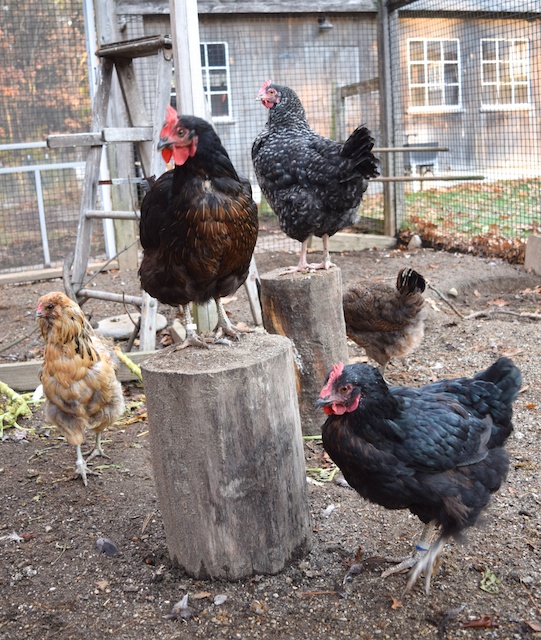
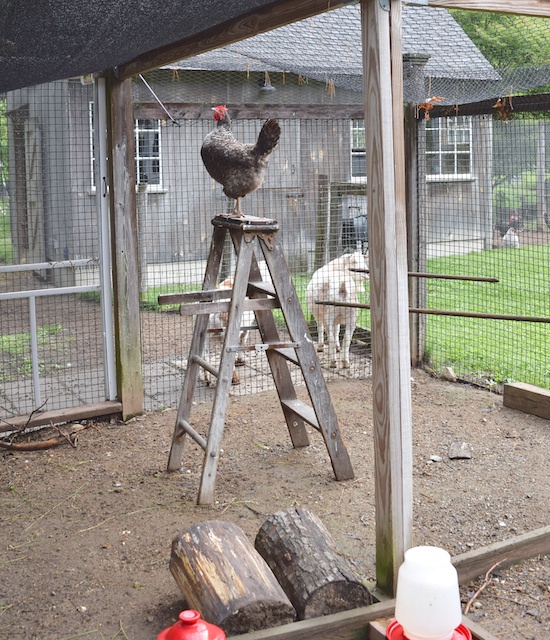
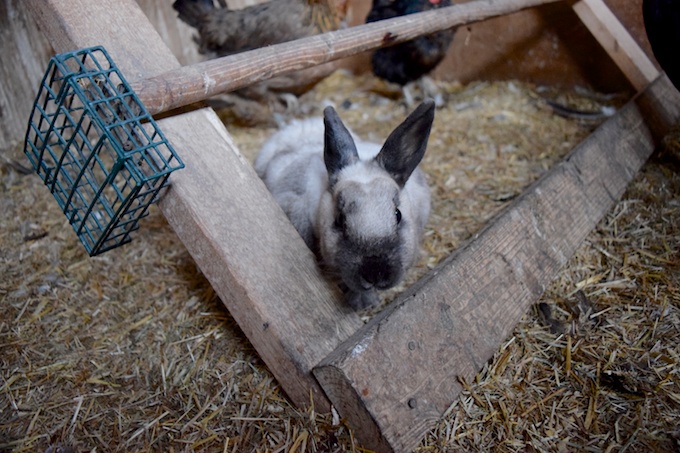

the only hen I had trouble getting to roost was my polish, mamie, I would find her burrowed behind things, but being a polish I wasn’t too concerned, she has finally joined the others on the roosts, but occasionally I still find her wedged someplace, she is a very silly chicken
I love going to tuck the Hens in at night and seeing where they have chosen to roost and who is beside who. Sometimes there will be a familiar pattern for awhile and just when you think they have established their spot…..someone mixes it up. There has been one consistent thing going on in regards to sleeping quarters of the birds. My Campine, Ancona and bantam Leghorn(roo), all fly up into the rafters of the outside part of their enclosure every evening, freezing weather or not. It was the first place the chose when they were introduced to their new home and they have never ventured further to roost since. They do switch up who they sleep next to though…It`s a chicken thing.
Great information again Terry! Thank you. My husband got hinges to put on the ‘old girl’s’ roost to make it easier to clean under, hopefully he can put them on soon….8-). I also got some fall chickens who are now 10 weeks old and I had to show them how to roost (picked them up from floor and placed them on roost when it was dark) only one time. They are so smart! On another subject….What do you think about pooh boards under roosts?
Boards under roosts to catch the manure, to keep the poo out of the bedding and to make the coop easier to clean, can be a good thing. Have them low down enough so that the hens aren’t breathing in manure fumes at night. Keep them scraped off frequently. However, if not maintained, then the board becomes a big pile of manure inside of the coop (I’ve seen that! Not a good thing.)
Our 3 hens have their roost pole one foot above a wooden board that is covered in pine shavings. We replace the pine shavings every morning so there is fresh pine shavings when then go to bed. Terry, do you think that is an okay setup?
It’s okay IF your coop is very well ventilated and because you clean daily!
The flat roost vs the round roost.
Here is a tidbit from my experience.
The initial roosts I placed in my coop were 2×4’s flat side up.
I then took a page from Terry’s book and found a old wooden ladder at a garage sale with round dowels.
I then took that ladder and screwed it to the one wall of my coop so that it was level (in other words it is no longer a ladder). I placed it at 30 inches above the coop floor which is the exact height of my first rung of my 2×4 roost. My 2×4 roost has three rungs to a max height of approx. 48 inches.
I can tell you the hens don’t seem to prefer one type over the other. Some hens are on the 2×4’s one night and then on the round dowel of the ladder the next.
All my girls roost however right now during their molt 2 have chosen to go to bed in the nest boxes. So every night I have to move them! This has only started since the molt. Interesting because one of them has a prime spot against a wall so like you said she doesn’t want to be smashed and prickly. So thanks for sharing . I wasn’t totally sure what was going on. The head lady has taken her spot. She was at the other end in the other choice spot. No one is sleeping in their usual places except my 2 bantams who always snuggle up to my 7 lb maran. Lol
I’ve had a problem with them sleeping and pooping in nesting boxes occasionally. Other than removal/relocating to a perch, any other tricks that might help? Maybe closing off a couple of the more pooped-in boxes?
The long-term solution is to lower the boxes and raise the roost. Also, if your hens have stopped laying for the molt, you can close off the boxes for a couple of weeks. Don’t do that if you still have layers, or you’ll make other problems (it’s always something!)
My 3 hens refuse to roost as well. I think I missed teaching them when they were small. After a year of going out every night and putting them on the roost, I just let them be in the nesting box. What a mess! When we built my coop we made the roost level with the nesting box thinking they would use the roost to climb into the nesting box–big mistake! Now they think the nesting box is higher and better so that doesn’t encourage roosting either. This chicken keeping is still a learning process no matter how much you read before hand! :)
My chickens loved when I moved rocks, stumps etc. They loved to forage for the worms, grubs etc that were under them. ;)